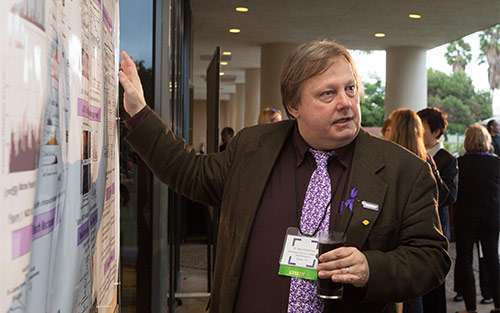
David Boothman, PhD, explains his research focus to volunteers at a Pancreatic Cancer Action Network event.
Researchers and clinicians have spent decades trying to devise ways to stop the growth and aggressive properties of pancreatic cancer cells – but the cells have proven astonishingly resilient and resistant to standard cancer treatments.

David Boothman, PhD, explains his research focus to volunteers at a Pancreatic Cancer Action Network event.
David Boothman, PhD, decided to take a completely different approach – by capitalizing on a cellular process that pancreatic cancer cells are especially good at, and “tricking” the cells into using that process to harm themselves.
Research published on December 13 in the highly regarded journal Cancer Cell suggests that Boothman and his colleagues are on the right track with their strikingly innovative approach.
Boothman is the Robert B. and Virginia Payne Professor of Oncology and Pharmacology, and associate director for translational research, at the University of Texas Southwestern Medical Center. He has received three research grants from our organization – most recently, a $300,000 Translational Research Grant in 2015.
“The critical funding from the Pancreatic Cancer Action Network has allowed us to ask bold, out-of-the-box questions,” Boothman said. “The translational grant in particular is supporting us taking the necessary steps – determining the optimal timing, dosing and combination strategy – so we can translate our laboratory findings into patient benefit.”
Boothman and his team’s approach focuses on a protein called NAD(P)H:quinone oxidoreductase 1 (NQO1) that is present at dramatically high levels in almost all pancreatic cancer cells but not in normal cells. They discovered that a drug called b-lapachone gets consumed by NQO1, and this process releases a toxic compound: hydrogen peroxide. Accumulation of hydrogen peroxide in the cancer cells results in severe damage to the cells’ DNA, which could result in the death of the life-threatening cells.
However, the research team soon found out that the pancreatic cancer cells had a way to bypass the toxicity of hydrogen peroxide – by quickly fixing the DNA damage and allowing cellular survival.
“We thought we were smarter than the cancer cells,” commented Boothman. “But those cells were still a step ahead of us. That’s when we decided to hit the cancer cells with a one-two punch and block their ability to repair the damage to the DNA, too.”
The results published in Cancer Cell demonstrate that combining b-lapachone with a drug that prevents the pancreatic cancer cells from fixing their DNA, called a PARP inhibitor, showed very encouraging results in a mouse model of pancreatic cancer. In fact, the combination was synergistic, meaning that the two drugs together were more effective than the individual effect of each drug. And, the combinatorial approach will allow patients to be treated with a lower dose of b-lapachone, reducing side effects.
The next step is to bring this drug combination to patients. A Phase I clinical trial is slated to begin in the spring 2017. Principal investigator of the trial will be gastrointestinal oncologist Muhammad (Shaalan) Beg, MD, who works closely with Boothman and is a co-investigator on his grants from us and a coauthor on the paper.
“Dave [Boothman] and I are part of a great multidisciplinary team,” Beg said. “He is a brilliant scientist who understands the intricacies of what makes cancer cells tick. And I provide input on how to best treat patients.”
Pancreatic cancer patients who participate in clinical research have better outcomes. Every treatment available today was approved through a clinical trial. The Pancreatic Cancer Action Network strongly recommends clinical trials at diagnosis and during every treatment decision.
For more information about this study, pancreatic cancer clinical trials or other disease resources, please contact PanCAN Patient Services.
















